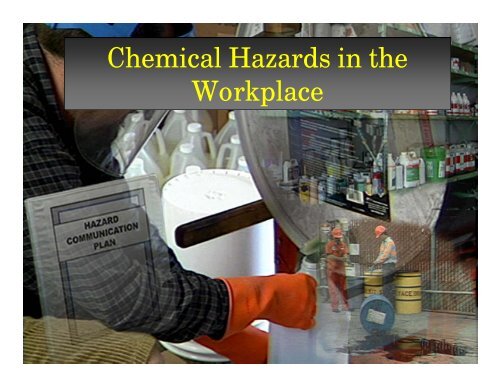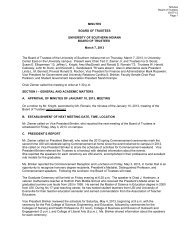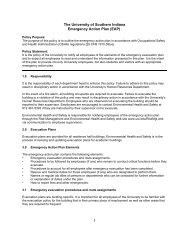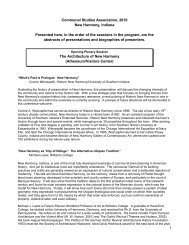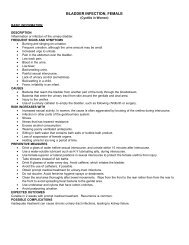Chemical Hazards in the Workplace
Chemical Hazards in the Workplace
Chemical Hazards in the Workplace
- No tags were found...
You also want an ePaper? Increase the reach of your titles
YUMPU automatically turns print PDFs into web optimized ePapers that Google loves.
<strong>Chemical</strong> <strong>Hazards</strong> <strong>in</strong> <strong>the</strong><strong>Workplace</strong>
<strong>Chemical</strong>s <strong>in</strong> <strong>the</strong> <strong>Workplace</strong>‣ There are 750,000hazardous chemicals used<strong>in</strong> <strong>the</strong> workplace around<strong>the</strong> world.• Hundreds more are addedevery year.‣ <strong>Chemical</strong>s are used for avariety of purposes.‣ Employees must knowhow to protect <strong>the</strong>mselvesfrom chemical hazards.
What is a Hazardous <strong>Chemical</strong>?‣ A hazardous chemical isany substance that posesa physical or healthhazard to you or o<strong>the</strong>rs<strong>in</strong> <strong>the</strong> workplace.
Hazardous <strong>Chemical</strong>s‣ Examples of Physicalhazards:• Fires• Explosions‣ Examples of Healthhazards:• Cancer• Sk<strong>in</strong> irritation• Respiratory ailments
Health <strong>Hazards</strong>‣ Health <strong>Hazards</strong> can beAcute or Chronic• Acute health hazardsoccur rapidly afteran exposure.• Chronic health hazardsoccur gradually afterrepeated exposures.
<strong>Chemical</strong> <strong>Hazards</strong>‣ The methods <strong>in</strong> which chemicals enter <strong>the</strong> body arecalled “routes of entry.”‣ Understand<strong>in</strong>g <strong>the</strong>se various routes of entry isnecessary to prevent exposure to hazardous chemicals.‣ There are three ma<strong>in</strong> “Routes of Entry” Absorption Inhalation Ingestion
Routes of Entry‣ Absorption• Occurs when contact with exposed sk<strong>in</strong> allows achemical to be absorbed <strong>in</strong>to <strong>the</strong> body.• To prevent absorption,wear proper protectiveequipment: <strong>Chemical</strong> gloves Aprons Coveralls
Routes of Entry‣ Inhalation• Can occur when chemicals become airborne <strong>in</strong> <strong>the</strong> formof a vapor, mist or dust allow<strong>in</strong>g <strong>the</strong>m to be <strong>in</strong>haled <strong>in</strong>to<strong>the</strong> lungs.• To prevent <strong>in</strong>hal<strong>in</strong>ghazardous chemicalsyou must select anduse proper respiratoryprotection.
Routes of Entry‣ Ingestion• Can occur when hazardous chemicals are eaten orswallowed.• To avoid <strong>in</strong>gest<strong>in</strong>ghazardous chemicalsnever:eatdr<strong>in</strong>kapply make-up• Always wash hands afterhandl<strong>in</strong>g chemicals .
<strong>Chemical</strong> <strong>Hazards</strong>‣ There are three ma<strong>in</strong> sources of <strong>in</strong>formation used toconvey a chemical’s hazards <strong>Chemical</strong> Manufacturer’s Label Supplemental Hazard Labels Material Safety Data SheetsHealthFlammabilityReactivity
Manufacturer’s Labels‣ The chemical manufacturer’s label is <strong>the</strong> first source of<strong>in</strong>formation about potential hazards, safe work practicesand PPE required for a specific chemical.
Manufacturer’s Labels‣ Manufacturer’s labels provide<strong>the</strong> follow<strong>in</strong>g <strong>in</strong>formation Commercial name of <strong>the</strong>chemical Name and address of <strong>the</strong>manufacturer Any physical or health hazardspresented by <strong>the</strong> chemical
Manufacturer’s Label‣ Some manufacturer’slabels <strong>in</strong>clude additional<strong>in</strong>formation such as:• Required PPE to be worn• Special handl<strong>in</strong>g• Storage requirements• First aid• Spill clean up
Supplemental labels‣ Additional supplementallabels are often used toquickly convey hazard<strong>in</strong>formation <strong>in</strong> an easyto read format• NFPA• HMIS
NFPA labels‣ NFPA labels rankhazards related to:‣ Each hazard is rankedon a scale from 0 to 4• Health• Flammability• Reactivity• Special Warn<strong>in</strong>gs
HMIS labels‣ HMIS labels use <strong>the</strong>same rank<strong>in</strong>g andcolors to display:• Health‣ Each hazard is rankedfrom 0 to 4• Flammability• Reactivity• PPE
O<strong>the</strong>r Labels‣ Many companies have<strong>the</strong>ir own label<strong>in</strong>g systemto identify chemicalhazards.‣ Be sure you know andunderstand how to read<strong>the</strong> label<strong>in</strong>g systems used<strong>in</strong> your facility.‣ If you have any questionsask your supervisor.
‣ <strong>Chemical</strong>s are oftentransferred from largeconta<strong>in</strong>ers to smallersecondary conta<strong>in</strong>ers.‣ When this occurs <strong>the</strong>secondary conta<strong>in</strong>ermust also be labeled.‣ NEVER use chemicalsfrom an unlabeledconta<strong>in</strong>er.O<strong>the</strong>r Labels
Material Safety Data Sheets‣ Material Safety DataSheets are ano<strong>the</strong>rsource of <strong>in</strong>formationabout a chemical’shazards‣ Every chemical <strong>in</strong> <strong>the</strong>workplace has aMaterial Safety DataSheet or MSDS‣ MSDS conta<strong>in</strong> moredetailed <strong>in</strong>formationthan labels
Material Safety Data Sheets‣ Material Safety DataSheets (MSDS) arereadily available foremployee review.‣ Make sure you know howto access <strong>the</strong>se importantdocuments.‣ Always consult MSDSbefore work<strong>in</strong>g with anychemical.
Material Safety Data Sheets‣ MSDS sheets are divided and numbered <strong>in</strong>tovarious sections, and while <strong>the</strong> arrangement of<strong>the</strong>se sections may vary, most material safety datasheets conta<strong>in</strong> <strong>the</strong> follow<strong>in</strong>g valuable<strong>in</strong>formation……
Material Safety Data Sheets‣ Product and Company Information:• This section will <strong>in</strong>clude <strong>the</strong> name of <strong>the</strong> chemical and <strong>the</strong>manufacturer.• An emergency contact number will also be listed.
Material Safety Data Sheets‣ Hazardous Ingredients:• This section will list <strong>the</strong> hazardous <strong>in</strong>gredientsconta<strong>in</strong>ed <strong>in</strong> <strong>the</strong> chemical, specifically nam<strong>in</strong>g anyknown carc<strong>in</strong>ogens.• Carc<strong>in</strong>ogens are substances known to cause cancer.
Material Safety Data Sheets‣ Hazard Identification:• This section will describe <strong>the</strong> hazards posed by <strong>the</strong>chemical.• This will <strong>in</strong>clude physical hazards, health hazards andenvironmental hazards.
Material Safety Data Sheets‣ First Aid:• When exposed to achemical, it’s importantto know what actions totake.• This section will list whatactions to take forspecific exposuresituations, such as contactwith eyes, <strong>in</strong>halation or<strong>in</strong>gestion.
Material Safety Data Sheets‣ Exposure Controls and Personal Protection:• This section will list occupationalexposure limits for <strong>the</strong> chemical aswell as required protective equipmentto be used.• Refer to this section to determ<strong>in</strong>eif chemical gloves, goggles or arespirator may be required.• Also listed <strong>in</strong> this section will beany recommended eng<strong>in</strong>eer<strong>in</strong>gcontrols that may be required.
Material Safety Data Sheets‣ Physical and <strong>Chemical</strong> Properties:• This section will list propertiessuch as boil<strong>in</strong>g po<strong>in</strong>t,flashpo<strong>in</strong>t, specific gravity,color and odor.• This <strong>in</strong>formation can be used topredict how <strong>the</strong> chemical willreact under certa<strong>in</strong> conditionsand can also be used to helpdetect leaks and spills.
Material Safety Data Sheets‣ Stability and Reactivity:• This section describes how <strong>the</strong> chemical will react whenexposed to o<strong>the</strong>r chemicals, water, air, sunlight or o<strong>the</strong>rfactors• Some chemicals will react violently under certa<strong>in</strong> conditions,if so it will be listed <strong>in</strong> this section
Material Safety Data Sheets‣ Handl<strong>in</strong>g and Storage:• This section gives safe handl<strong>in</strong>g and storage <strong>in</strong>structions• Follow<strong>in</strong>g proper handl<strong>in</strong>g and storage <strong>in</strong>structions canprevent needless exposures and also prevent leaks,spills, fires or explosions.
Material Safety Data Sheets‣ Toxicological Information:• Describes <strong>the</strong> various routes of entry for <strong>the</strong> chemicaland any acute or chronic health effects of exposure
Written HazardCommunication Plan‣ <strong>Chemical</strong> labels and MSDS are just part of a largerwritten program ma<strong>in</strong>ta<strong>in</strong>ed by <strong>the</strong> company tocontrol exposure to hazardous chemicals.‣ OSHA requires chemical hazards be communicatedto employees through <strong>in</strong>formation and tra<strong>in</strong><strong>in</strong>g.‣ This tra<strong>in</strong><strong>in</strong>g is commonly called “HazardCommunication Tra<strong>in</strong><strong>in</strong>g” or “Right To KnowTra<strong>in</strong><strong>in</strong>g.”
Written HazardCommunication Plan‣ The written plan isdesigned to be acomprehensive plan tocontrol exposures tohazardous chemicals.‣ This plan is available tomanagement andemployees for review.
Summary‣ Hazardous chemicals are substances that pose aphysical or health hazard.
Summary‣ Hazardous chemicals enterour bodies through “Routesof Entry.”‣ There are three ma<strong>in</strong> routesof entry:• Absorption• Inhalation• Ingestion
Summary‣ <strong>Chemical</strong> manufacturer’s labels are <strong>the</strong> first sourceof <strong>in</strong>formation about a chemical.‣ These labels conta<strong>in</strong>:• Commercial name• Name and address of manufacturer• Physical and health hazards
Summary‣ Supplemental hazard labels provide quick and easy<strong>in</strong>formation about a chemical’s hazards‣ NFPA and HMIS labels rank health, flammability,and reactivity hazards on a scale from 0 to 4NFPA14 2HMISHealthFlammabilityReactivity
Summary‣ NFPA labels reserve<strong>the</strong> lower section forspecial warn<strong>in</strong>gs.SpecialWarn<strong>in</strong>gs‣ While HMIS labelsreserve <strong>the</strong> lowersection for requiredprotective equipment.PPE
Summary‣ If you have any questionsabout <strong>the</strong> chemical labelsused <strong>in</strong> your facility askyour supervisor.
Summary‣ Material Safety Data Sheets are ano<strong>the</strong>r source ofchemical <strong>in</strong>formation‣ MSDS provide more detailed <strong>in</strong>formation thanchemical labels and are always available foremployee review
Summary‣ The company’s written hazardcommunication plan is acomprehensive plan to controlexposures to hazardous chemicals‣ The company’s plan requires allemployees to receive “hazardcommunication tra<strong>in</strong><strong>in</strong>g” beforework<strong>in</strong>g with hazardous chemicals
Summary‣ Secondary conta<strong>in</strong>ers must be labeled also• You may use a permanent marker or o<strong>the</strong>r label that willnot easily be removed• Write <strong>the</strong> name of <strong>the</strong> chemical <strong>in</strong> bold easy to read lettersfor o<strong>the</strong>rs to see• Serious <strong>in</strong>jury couldresult if this isnot followed
Summary‣The written Hazard Communication Programis available onl<strong>in</strong>e athttp://www.usi.edu/Riskmgt/. A hard copy canbe obta<strong>in</strong>ed from my office located <strong>in</strong> <strong>the</strong>Support Services Build<strong>in</strong>g.‣A master list of hazardous chemicals andMSDS is located <strong>in</strong> <strong>the</strong> Security build<strong>in</strong>g
Summary‣ Employees have <strong>the</strong> responsibility to put <strong>the</strong>irtra<strong>in</strong><strong>in</strong>g <strong>in</strong>to action through <strong>the</strong> proper use ofProtective Equipment and by always follow<strong>in</strong>gSafe Work Practices while work<strong>in</strong>g withhazardous chemicals


